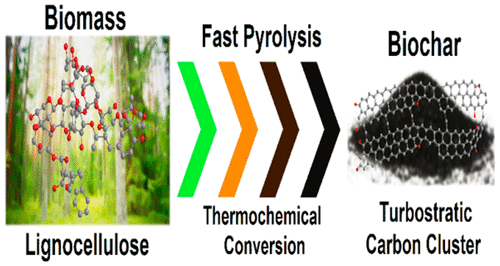当前位置:
X-MOL 学术
›
ACS Sustain. Chem. Eng.
›
论文详情
Our official English website, www.x-mol.net, welcomes your
feedback! (Note: you will need to create a separate account there.)
Structural Characterization of Loblolly Pine Derived Biochar by X-ray Diffraction and Electron Energy Loss Spectroscopy
ACS Sustainable Chemistry & Engineering ( IF 7.1 ) Pub Date : 2018-01-25 00:00:00 , DOI: 10.1021/acssuschemeng.7b04119 Seunghyun Yoo 1 , Stephen S. Kelley 1 , David C. Tilotta 1 , Sunkyu Park 1
ACS Sustainable Chemistry & Engineering ( IF 7.1 ) Pub Date : 2018-01-25 00:00:00 , DOI: 10.1021/acssuschemeng.7b04119 Seunghyun Yoo 1 , Stephen S. Kelley 1 , David C. Tilotta 1 , Sunkyu Park 1
Affiliation

|
Biochar from lignocellulosic biomass is emerging as a sustainable material with versatile applications, but its detailed properties are poorly understood because of its structural complexity. We propose a biochar structural development model based on experimental results including composition analysis, surface area and pore analysis, X-ray diffraction analysis, electron microscopy imaging, and electron energy loss spectroscopy. Loblolly pine derived biochars were produced at different carbonization temperatures between 300 to 1000 °C. Fixed carbon, sp2 content, and number of graphene layers increased with increased carbonization temperature. Alternating average C–C bond length, interlayer spacing distance, and layer coherence length were observed. Bulk plasmon excitation energy was correlated to the average C–C bond length, and it serves as a good indicator of the carbon structure development when compared to the perfect graphitic carbon structure. On the basis of the experimental results, four different structural development phases are identified, which provide a comprehensive understanding of biochar nanocarbon crystallite development. Unlike previous biochar structure models, which proposed radially growing polyaromatic carbon crystallite, we propose a lengthwise growing polyaromatic carbon crystallite model. This experiment-based biochar model should be helpful when determining the structure of unknown biomass-derived carbon materials and disordered pyrolytic carbon materials.
中文翻译:

火炬松衍生生物炭的X射线衍射和电子能量损失谱结构表征
来自木质纤维素生物质的生物炭正在作为具有多种用途的可持续材料出现,但由于其结构复杂性,人们对其详细特性了解甚少。我们基于实验结果提出生物炭结构发展模型,包括组成分析,表面积和孔分析,X射线衍射分析,电子显微镜成像和电子能量损失谱。火炬松的生物炭是在300至1000°C的不同碳化温度下生产的。固定碳,sp 2碳化温度的升高,石墨烯的含量和石墨烯层数增加。观察到交替的平均C–C键长度,层间间隔距离和层相干长度。体等离子体激元激发能与平均C–C键长相关,与理想的石墨碳结构相比,它可作为碳结构发展的良好指标。根据实验结果,确定了四个不同的结构发展阶段,这提供了对生物炭纳米碳微晶发展的全面理解。与以前的生物炭结构模型不同,该模型提出了径向生长的聚芳族碳微晶,而我们提出了纵向生长的聚芳族碳微晶。
更新日期:2018-01-25
中文翻译:

火炬松衍生生物炭的X射线衍射和电子能量损失谱结构表征
来自木质纤维素生物质的生物炭正在作为具有多种用途的可持续材料出现,但由于其结构复杂性,人们对其详细特性了解甚少。我们基于实验结果提出生物炭结构发展模型,包括组成分析,表面积和孔分析,X射线衍射分析,电子显微镜成像和电子能量损失谱。火炬松的生物炭是在300至1000°C的不同碳化温度下生产的。固定碳,sp 2碳化温度的升高,石墨烯的含量和石墨烯层数增加。观察到交替的平均C–C键长度,层间间隔距离和层相干长度。体等离子体激元激发能与平均C–C键长相关,与理想的石墨碳结构相比,它可作为碳结构发展的良好指标。根据实验结果,确定了四个不同的结构发展阶段,这提供了对生物炭纳米碳微晶发展的全面理解。与以前的生物炭结构模型不同,该模型提出了径向生长的聚芳族碳微晶,而我们提出了纵向生长的聚芳族碳微晶。











































 京公网安备 11010802027423号
京公网安备 11010802027423号